
Wine Culture and Information since 2002 - Volume 22
 Wine Culture and Information since 2002 - Volume 22 |
|
Comparative TastingThe study of different wines helps the improving of the taster's sensorial capacities and offers an important help to the development of olfactory and gustatory memory |
|
The exercise of wine sensorial tasting certainly is a pleasure for the expert connoisseurs - as well as for the neophyte - anyway it also represents a pretty complex practice requiring a lot of experience before getting the most out of it and the best satisfaction. The experience is the most useful quality of the taster, a quality which is obviously acquired with practice, attention, awareness, commitment and, last but not the least, with time. It is also true the process of acquiring experience can be shortened by using a good method while leaving to chance or to circumstance the least influence possible. However it is good to remember that also the occasions offered by chance and by circumstance are always useful and indispensable for the development of the taster's sensorial capacities. In other words, it is always good to get the most out of any tasting opportunity, both the ones prepared with method and logic, as well as the ones offered by informal and quick occasions, such as a visit to a winery, a wine festival or a wine fair.
One of the quality which have always impressed neophytes is the capacity - real or supposed - of professional taster to recognize the presence of a certain grape in a wine, the area of origin, the vintage and the producer. It should be remembered these spectacular qualities not only require a scrupulous and methodic study of thousands of wines, and that in most of the cases it is simply possible to recognize some qualities of the wine only, certainly the most identifying ones, such as the grape variety and the area. It is also true the style of many producers is so evident which is practically hard not to recognize it in their wines, both whites and reds. However, despite the capacities of a taster, it is possible to recognize something - and therefore a wine as well - only in case it is already known. It can be recognized, for example, the presence of Nebbiolo in a wine only in case the qualities of Nebbiolo are known. This competence - there is no alternative to this - can be acquired with the practice of Nebbiolo tasting only. Studying just one wine certainly is useful, however this study can be more efficient and positive in case a comparative method is being used. It is the comparison of two or more things - the possibility of comparing an element with another - which allows the taster to better remember its characteristics thanks to contrast or analogy relative to other factors. In this sense, comparison is an extremely useful exercise to the formation of a taster's capacities, as it allows the study of analogies and differences existing between two or more wines. For this reason it is always preferred, in educational tasting sessions, to have many samples - at least three - in order to allow the useful exercise of comparison. The goal is not to determine what sample is the best: the purpose is just to highlight the qualities and characteristics of each wine.
|
||||||||
|
Like already mentioned, the goal of comparative tasting is to highlight the differences and analogies of many wines with the purpose of comparing one to each other. This does means it will be appropriate to organize a comparative tasting by using specific criteria and that however will let tasters to achieve a result according to the goal. There can be organized comparative tastings - at least in theory - for any type of wine by choosing the samples accordingly. Of course it would make no practical or educational sense a comparative tasting of wines completely different in type, saved the case it is wished to highlight a specific quality in a clearly evident way. In this sense, it would have scarce sense to have a comparative tasting of a white wine, a red wine and a classic method sparkling wine, saved the case of highlighting the evident differences and that would however be obvious without organizing a tasting. In other words, every comparative tasting should be organized according to a specific subject and however the wines should have at least one quality in common, such as all red wines or all white wines.
|
|
A Horizontal tasting consists in the study and comparison of wines belonging to the same vintage, same area or appellation but of different producers. The wines of a horizontal tasting must scrupulously belong to the same area or appellation and type. In order to make this concept clear, in case a horizontal tasting is being organized about Cirò DOC wines - which allows the production of white, rose and red wines - it is essential all wines to belong to the very same type and it would not make much sense to compare different types together. Therefore the goal of a horizontal tasting should be the comparison of wines with similar qualities - with the exception of the producer - such as “Sagrantino di Montefalco 2000”, “Amarone della Valpolicella 1999” or “Chianti Classico 2001”. The goal of a horizontal tasting can be both the determination of the best producer as well as the study of the enological qualities of each winery, its style and the use a producer makes of a grape and of a territory.
|
|
Among comparative tastings, the vertical one probably is the most famous and it certainly is the one having a higher charm. A vertical tasting consists in the study and in the comparison of the same wine, of the same producer but belonging to different vintages. It is then a historical evaluation of the evolution potentialities of a specific winery's wine. The most interesting aspect of a vertical tasting is represented by the possibility of the study about the qualities of a single vintage as well as the evolution potentialities of a specific wine. A vertical tasting can be considered as useful in case it is made of at least three samples and a very good vertical tasting should have at least five samples. The choice of vintages can follow any criterion. There can be chosen, for example, five consecutive vintages or even vintages belonging to different decades. The goal of a vertical tasting could also be the determination of the best vintage, however it is good to remember that it does not make much sense to compare two wines whose age differs of many years as their organoleptic qualities will evidently be different, if not distant. The goal of a vertical tasting essentially is the study of the evolution potentialities over time and the qualitative reliability.
|
|
Among all comparative tasting, the diagonal one is the less common as it does not allow an efficient study because of the differences of the wines. A diagonal tasting consists in the evaluation of wines belonging to the same type and area but of different vintages and producers. In other words it is a tasting made of wines having as the only common factor of belonging to the same area or appellation. It is right this only common factor to make the diagonal tasting not very used because it does not offer good comparative opportunities of study with the exception of evaluating each wine. This is essentially because of the fact a diagonal tasting does not allow to efficiently compare the samples which make it, saved the evaluation of the evolution possibilities of the wines of a specific area.
|
|
This type of tasting offers interesting opportunity of study and comparison. Varietal tasting are defined in two types and according to the wines which make it. The first type of varietal tasting is made of wines produced with the same grape but coming from different areas, whereas the second type is made of monovarietal wines produced with different grapes and belonging to the same category, that is white berried or red berried varieties. The first type of tasting allows the study of the differences of the same grape in relation to the territory and the soil type. To this type of tasting also belong the ones done with wine samples produced with the same grape but harvested in different periods or produced by using different wine making techniques (late harvests, dried grapes, use of barrique or cask) in order to study the influence of any single factor. The second type - made of monovarietal wines and produced with different grapes - is useful for highlighting, because of the effect of contrast, the specific qualities of a single variety. This type of tasting, for example, offers a good help for the recognition of the many aromatic grapes (Muscat Blanc, Gwürztraminer, Sauvignon Blanc) as well as non aromatic or semi aromatic grapes.
|
|
As it is known, the organoleptic qualities of a wine are also determined by the territory, the quality of its soil and its micro climate. The goal of a territorial tasting is the study of the characteristics of a territory and the influence on its wines. This type of tasting is made of wines produced in the same territory, in particular a specific appellation or wine region, and however not too excessively wide. Examples of territorial tasting could include Barolo wines coming from the five main areas, Burgundy's Pinot Noir or crus of Chablis. The study of territorial tasting is extremely interesting as it allows the recognition and the comparison of the climate and geological influences of the many areas. The efficiency of territorial tasting can be increased in case all the wines making it are produced by the same winery, a condition which allows to “filter” as much as possible the influence of the wine making practices - which are in this case supposed to be homogeneous - while highlighting the qualities of a single territory.
|
|
Organizing a comparative tasting mainly depends on its goal. There can be defined two types: educational tasting and recognition tasting. The goal of educational tasting is to allow the taster to acquire the necessary knowledge useful for doing a recognition tasting, which is more difficult and requiring experience. In educational tastings the characteristics of the wine samples will be known before the beginning of the tasting. This will allow the taster to associate the qualities really perceived on the glass to the corresponding and actual wine. It is also appropriate that to this type of tasting take part more tasters - even of different experience and competence - in order to have a profitable discussion during the evaluation of any sample. Wines will be served in the glasses before the beginning of the tasting in order to allow the taster to make comparisons and to highlight analogies and differences. The goal of a recognition tasting is to exercise the capacities of a taster in recognizing a specific type of wine while trying to highlight as many characteristics as possible. For this reason recognition tastings are strictly done blind - that is by putting samples in proper bags in order to conceal both the shape of the bottle and the label - however the subject can be known. Despite a recognition tasting can be done by a group of tasters, it is essential each one of them will work in complete autonomy because in this case the goal is to exercise the taster's sensorial capacities without having any kind of support or help. The comparison and the discussion with the other participants can be done at the end of the whole tasting session. Even in this type of tasting the samples will be served in the glasses before the beginning, however - in order to make the recognition process more interesting - the tasting of each sample can be done in succession.
|
||||
Wines of the Month |
|
|
|
Score legend Prices are to be considered as indicative. Prices may vary according to the country or the shop where wines are bought |
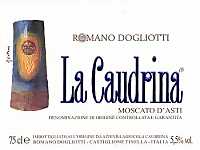
|
|
Moscato d'Asti La Caudrina 2004 |
|
| Caudrina - Romano Dogliotti (Italy) | |
| Grapes: Muscat Blanc | |
| Price: € 10.00 | Score: |
| The wine shows an intense greenish yellow color and nuances of greenish yellow, very transparent, good effervescence, fine and persistent perlage. The nose denotes intense, clean, pleasing and refined aromas which start with hints of grape and peach followed by aromas of pear, acacia, banana, litchi and sage. In the mouth has good correspondence to the nose, an effervescent attack, sweet and pleasing crispness, however balanced, light body, intense flavors, agreeable. The finish is persistent with flavors of grape, peach and litchi. This Moscato d'Asti is fermented in sealed tanks. | |
| Food Match: Cream desserts, Cream semifreddo, Soft cakes | |
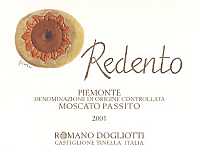
|
|
Piemonte Moscato Passito Redento 2001 |
|
| Caudrina - Romano Dogliotti (Italy) | |
| Grapes: Muscat Blanc | |
| Price: € 15.00 - 375ml | Score: |
| This wine shows a brilliant amber yellow color and nuances of golden yellow, transparent. The nose reveals good personality with intense, clean, pleasing, refined and elegant aromas which start with hints of raisin, peach jam and tangerine followed by aromas of dried fig, quince jam, date, lavender, almond, honey, ripe pear, walnut, citrus fruit peel, enamel and vanilla. In the mouth has good correspondence to the nose, a sweet attack and pleasing crispness, however balanced by alcohol, good body, intense flavors, agreeable. The finish is persistent with flavors of raisin, peach jam, date and honey. A well made wine. Redento is produced with dried Muscat Blanc grapes and ages for about 18 months in barrique followed by 6 months of aging in bottle. | |
| Food Match: Hard and piquant cheese, Almond and hazelnut cakes, Confectionery | |
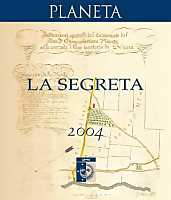
|
|
La Segreta Bianco 2004 |
|
| Planeta (Italy) | |
| Grapes: Grecanico (50%), Chardonnay (30%), Viognier (10%), Fiano (10%) | |
| Price: € 7.00 | Score: |
| The wine shows an intense straw yellow color and nuances of golden yellow, very transparent. The nose denotes intense, clean and pleasing aromas which start with hints of hawthorn, plum and apple followed by aromas of banana, pineapple, broom and pear. In the mouth has good correspondence to the nose, a crisp attack and however balanced by alcohol, good body, intense flavors. The finish is persistent with flavors of plum and apple. This wine ages in steel tanks. | |
| Food Match: Fried fish, Fish and vegetables appetizers, Eggs, Pasta and risotto with fish and crustaceans | |
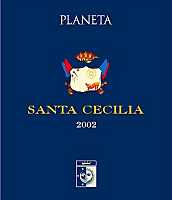
|
|
Santa Cecilia 2002 |
|
| Planeta (Italy) | |
| Grapes: Nero d'Avola | |
| Price: € 18.50 | Score: |
| This wine shows an intense ruby red color and nuances of ruby red, little transparency. The nose reveals intense, clean, pleasing and refined aromas which start with hints of plum and black cherry followed by aromas of blueberry, violet, tobacco, licorice, cocoa, vanilla, blackberry and eucalyptus. In the mouth has good correspondence to the nose, a slightly tannic attack and pleasing smoothness, however balanced by alcohol, good body, intense flavors, good tannins. The finish is persistent with flavors or black cherry, plum and blueberry. Santa Cecilia ages for 12 months in barrique. | |
| Food Match: Roasted meat, Braised and stewed meat, Hard cheese | |
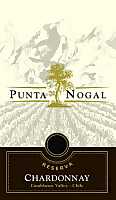
|
|
Chardonnay Reserva 2003 |
|
| Punta Nogal (Chile) | |
| Grapes: Chardonnay | |
| Price: € 6.50 | Score: |
| This Chardonnay shows a brilliant golden yellow color and nuances of golden yellow, very transparent. The nose denotes intense, clean, pleasing and refined aromas which start with hints of banana and vanilla followed by aromas of acacia, apple, yeast, hazelnut, grapefruit and praline. In the mouth has good correspondence to the nose, a crisp attack and pleasing roundness, however balanced by alcohol, good body, intense flavors. The finish is persistent with flavors of banana, apple and grapefruit. This Chardonnay ferments and ages in barrique. | |
| Food Match: Mushrooms and fish soups, Stuffed pasta, Roasted fish, Roasted white meat | |
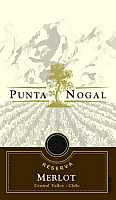
|
|
Merlot Reserva 2002 |
|
| Punta Nogal (Chile) | |
| Grapes: Merlot | |
| Price: € 6.50 | Score: |
| The wine shows an intense ruby red color and nuances of ruby red, little transparency. The nose denotes intense, clean, pleasing and refined aromas which start with hints of black cherry and plum followed by aromas of black currant, violet, vanilla, blackberry, licorice and carob. In the mouth has good correspondence to the nose, a slightly tannic attack and pleasing roundness, however balanced by alcohol, good body, intense flavors, good tannins. The finish is persistent with flavors of black cherry, plum and blackberry. This Merlot ages in barrique. | |
| Food Match: Broiled meat and barbecue, Stewed meat, Stuffed pasta | |
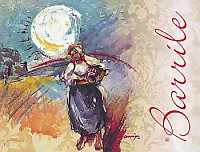
|
|
Barrile 2000 |
|
| Attilio Contini (Italy) | |
| Grapes: Nieddera, Caddiu | |
| Price: € 27.50 | Score: |
| This wine shows an intense ruby red color and nuances of garnet red, little transparency. The nose denotes intense, clean, pleasing and refined aromas that start with hints of black cherry and plum followed by aromas of blueberry, blackberry, vanilla, licorice, cocoa, cinnamon, tobacco and hints of menthol. In the mouth has good correspondence to the nose, a slightly tannic attack and pleasing roundness, however balanced by alcohol, good body, intense flavors, good tannins, agreeable. The finish is persistent with flavors of black cherry, plum and blueberry. A well made wine. Barrile ages for 10-12 months in barrique followed by at least 6 months of aging in bottle. | |
| Food Match: Roasted meat, Game, Braised and stewed meat, Hard cheese | |
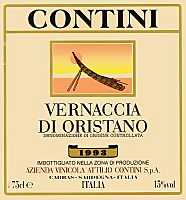
|
|
Vernaccia di Oristano 1993 |
|
| Attilio Contini (Italy) | |
| Grapes: Vernaccia di Oristano | |
| Price: € 13.20 | Score: |
| The wine shows an intense amber yellow color and nuances of amber yellow, transparent. The nose reveals intense, clean, pleasing and refined aromas which start with hints of almond and dried fig followed by aromas of honey, walnut, orange marmalade, caramel, date, licorice, lavender and hints of enamel. In the mouth has good correspondence to the nose, a slightly crisp attack and pleasing smoothness, however balanced by alcohol, full body, intense flavors. The finish is persistent with flavors of dried fig, almond, date and honey. This Vernaccia di Oristano ages in oak and chestnut casks for 10 years. | |
| Food Match: Almond desserts, Mullet botargo, Roasted meat, Hard cheese | |
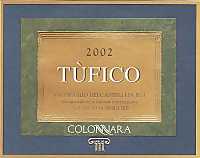
|
|
Verdicchio dei Castelli di Jesi Classico Superiore Tufico 2002 |
|
| Colonnara (Italy) | |
| Grapes: Verdicchio | |
| Price: € 12.00 | Score: |
| Tufico shows a brilliant straw yellow color and nuances of straw yellow, very transparent. The nose reveals intense, clean, pleasing and refined aromas which start with hints of hawthorn, plum and apple followed by aromas of broom, yeast, almond, pear, grapefruit and hints of mineral. In the mouth has good correspondence to the nose, a crisp attack and pleasing roundness, however well balanced by alcohol, good body, intense flavors, agreeable. The finish is persistent with flavors of plum, apple and almond. A well made wine. Tufico is produced with late harvested grapes, ages for 7 months in steel tanks followed by at least 6 months of aging in bottle. | |
| Food Match: Roasted fish, Fish and mushrooms soups, Stuffed pasta, Pasta with fish, Roasted white meat | |
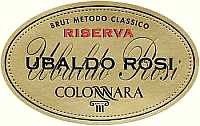
|
|
Brut Metodo Classico Riserva Ubaldo Rosi 1998 |
|
| Colonnara (Italy) | |
| Grapes: Verdicchio | |
| Price: € 20.00 | Score: |
| This wine shows a brilliant straw yellow color and nuances of straw yellow, very transparent, fine and persistent perlage. The nose reveals good personality with intense, clean, pleasing, refined and elegant aromas which start with hints of hawthorn, bread crust and yeast followed by aromas of pineapple, butter, plum, jasmine, almond, pear, apple and laurel. In the mouth has good correspondence to the nose, a crisp and effervescent attack, however well balanced by alcohol, good body, intense flavors, agreeable. The finish is very persistent with long flavors of apple, plum and almond. A well made sparkling wine. Reserve Ubaldo Rosi ages in the bottle on its lees for at least 5 years. | |
| Food Match: Roasted fish, Roasted white meat, Broiled crustaceans, Stuffed pasta with mushrooms | |
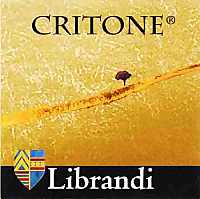
|
|
Critone 2004 |
|
| Librandi (Italy) | |
| Grapes: Chardonnay (90%), Sauvignon Blanc (10%) | |
| Price: € 6.00 | Score: |
| This wine shows a brilliant straw yellow color and nuances of greenish yellow, very transparent. The nose denotes intense, clean, pleasing and refined aromas which start with hints of hawthorn, pear and apple followed by aromas of acacia, pineapple, banana, broom and peach. In the mouth has good correspondence to the nose, a crisp attack and pleasing roundness, however well balanced by alcohol, good body, intense flavors, agreeable. The finish is persistent with flavors of pineapple, pear and peach. Critone ages in steel tanks. | |
| Food Match: Mushrooms soups, Sauteed fish, Pasta and risotto with fish and crustaceans | |
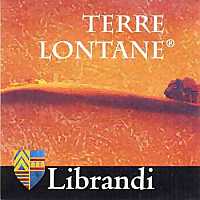
|
|
Terre Lontane 2004 |
|
| Librandi (Italy) | |
| Grapes: Gaglioppo (70%), Cabernet Franc (30%) | |
| Price: € 6.00 | Score: |
| This wine shows an intense cherry pink color and nuances of cherry pink, transparent. The nose reveals intense, clean, pleasing and refined aromas which start with hints of cherry and raspberry followed by aromas of cyclamen, strawberry, blueberry, plum, peach and rose. In the mouth has good correspondence to the nose, a crisp attack and however balanced by alcohol, good body, intense flavors, agreeable. The finish is persistent with flavors of raspberry, cherry and plum. Terre Lontane ages in steel tanks. | |
| Food Match: Legumes and mushrooms soups, Fish soups, Pasta with mushrooms, Roasted fish, Roasted white meat | |
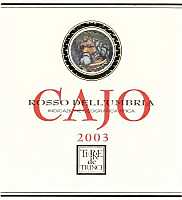
|
|
Cajo 2003 |
|
| Terre de' Trinci (Italy) | |
| Grapes: Sagrantino, Merlot, Cabernet Sauvignon | |
| Price: € 7.15 | Score: |
| This wine shows a brilliant ruby red color and nuances of garnet red, moderate transparency. The nose reveals intense, clean, pleasing and refined aromas which start with hints of black cherry, blackberry and plum followed by aromas of blueberry, vanilla, violet, licorice and tobacco. In the mouth has good correspondence to the nose, a slightly tannic attack and however balanced by alcohol, good body, intense flavors, good tannins. The finish is persistent with flavors of black cherry, plum and blackberry. Cajo ages for 6 months in cask. | |
| Food Match: Roasted meat, Braised and stewed meat, Hard cheese | |
|
|
|
Sagrantino di Montefalco Ugolino 2000 |
|
| Terre de' Trinci (Italy) | |
| Grapes: Sagrantino | |
| Price: € 25.40 | Score: |
| The wine shows an intense ruby red color and nuances of garnet red, little transparency. The nose reveals intense, clean, pleasing and refined aromas which start with hints of blackberry, black cherry and plum followed by aromas of violet, carob, licorice, tobacco, vanilla and cinnamon. In the mouth has good correspondence to the nose, a tannic attack and however balanced by alcohol, full body, intense flavors, good tannins. The finish is persistent with flavors of blackberry, black cherry and plum. Sagrantino Ugolino ages for 12 months in barrique. | |
| Food Match: Game, Braised and stewed meat, Roasted meat, Hard cheese | |
|
||||||||
|
DiWineTaste Polls
|
| |||||||
Privacy Policy | |||||||


| Copyright © 2002-2024 Antonello Biancalana, DiWineTaste - All rights reserved |
| All rights reserved under international copyright conventions. No part of this publication and of this WEB site may be
reproduced or utilized in any form or by any means, electronic or mechanical, without permission in writing from DiWineTaste. |